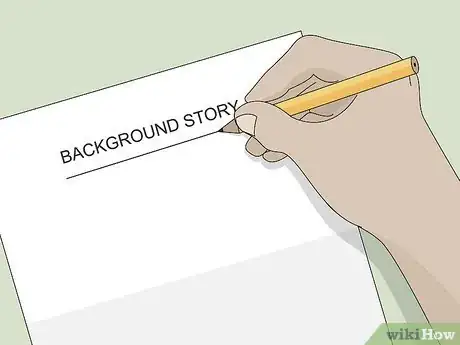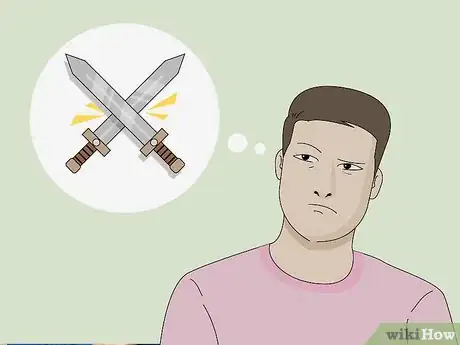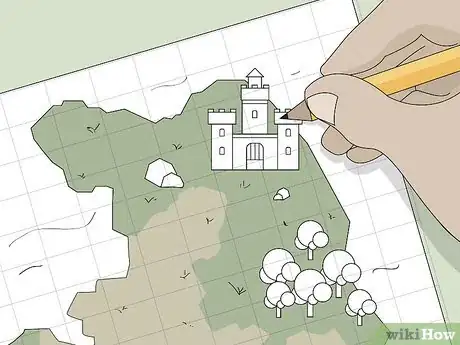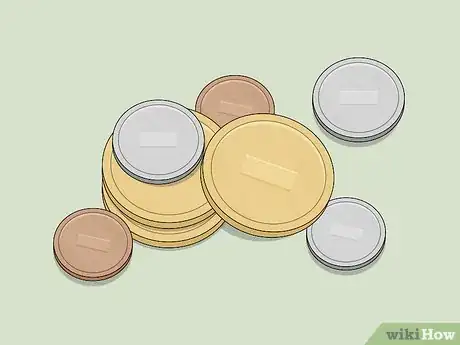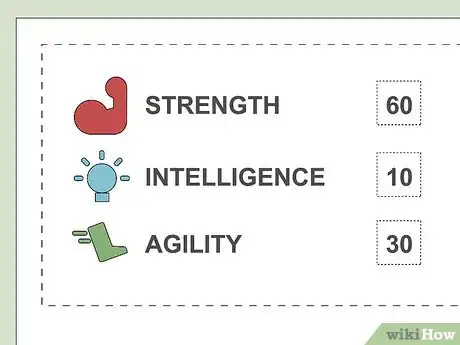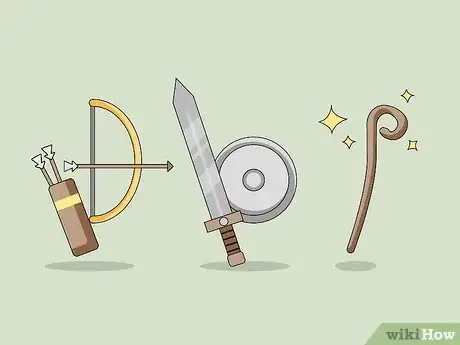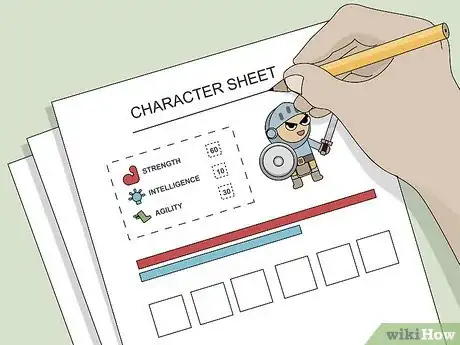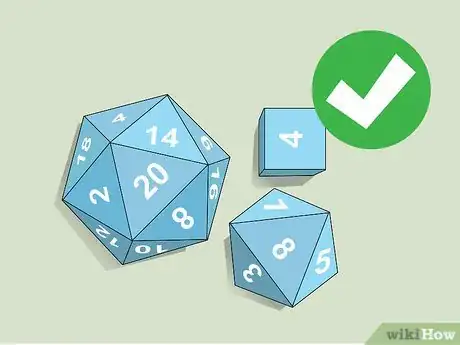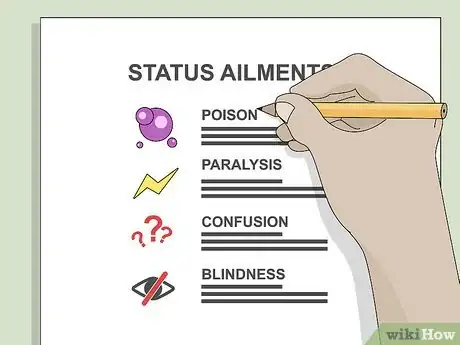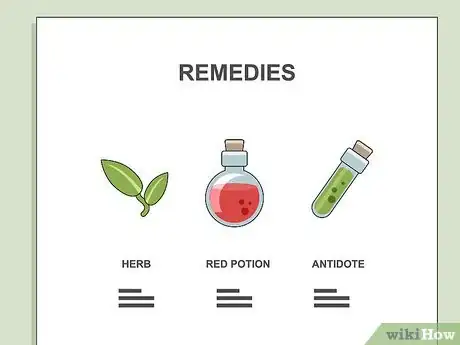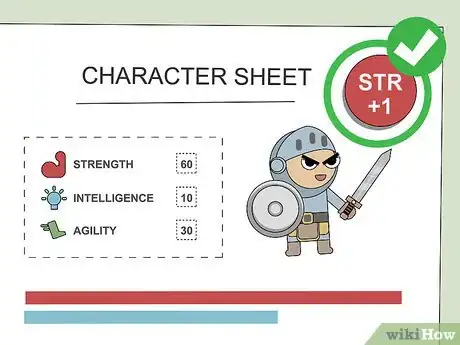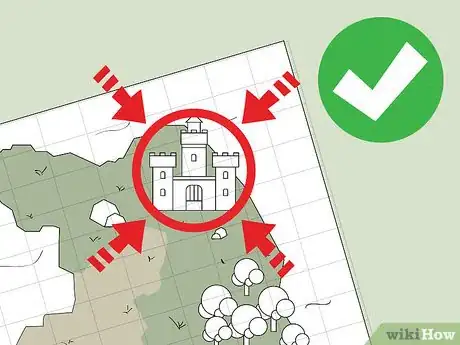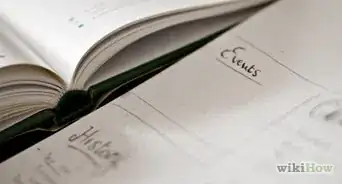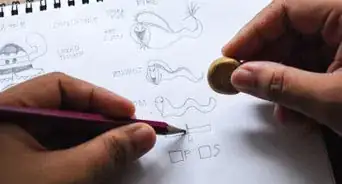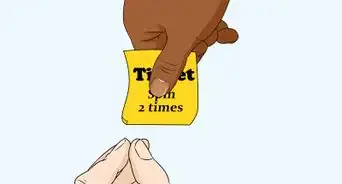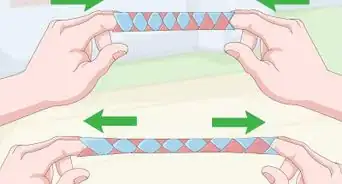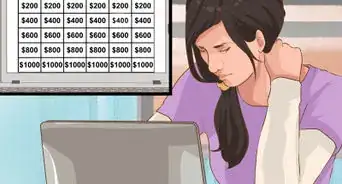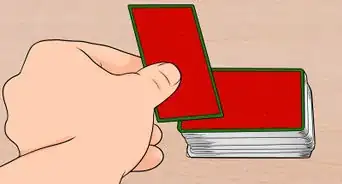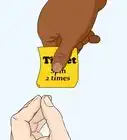X
This article was co-authored by wikiHow Staff. Our trained team of editors and researchers validate articles for accuracy and comprehensiveness. wikiHow's Content Management Team carefully monitors the work from our editorial staff to ensure that each article is backed by trusted research and meets our high quality standards.
This article has been viewed 141,170 times.
Learn more...
Role-playing games are a fun way to immerse yourself in a world of your own creation. Designing your own game is a fun challenge and a great way to exercise your imagination create a setting, characters, objectives, rules, a way to win, and then invite your friends over to play!
Steps
Part 1
Part 1 of 3:
Setting the Scene
-
1Write the background story of your game. This helps to set the scene for the game and provides the base for creating characters, conflicts, and remedies. Write a summary of the history, mythology, and culture of the world where your role-playing game (RPG) is set. This adds depth to your game and helps it to feel realistic.[1]
- For example, your game could be set in a big city in the year 2600 right after a war or in the middle of an uprising. This would provide a good base for creating your conflicts and objectives.
- Read the background story of the game out loud to all the players before playing the game. If there is specific information that the players need to know throughout the game, consider writing this on separate sheets of paper that the players can use for reference.
-
2Determine the main conflict in your RPG. The conflict could be a person, such as a villain, or an event, such as a natural disaster or viral disease. The conflict will help to provide the objective of the game. For example, if the conflict is a tsunami, the objective could be to get to higher ground.[2]
- If you need inspiration, use history to give you ideas. Research wars, uprisings, disease outbreaks, and natural disasters.
Advertisement -
3Draw a map of the world where the game is set. This helps the game to feel more realistic. Make a note on the map of the key cities and resource hubs. Don’t worry if you aren’t a Picasso prodigy, use simple shapes and annotations to create the map.[3]
- Consider drawing the map onto an A3 sheet of paper so that it is big enough for all the players to see easily.
- If you feel creative, consider drawing multiple maps. For example, the first map could be an overview of the country or continent and the second map could be a zoomed in view of the city where the players live.
- If the game has a battle arena, draw this onto the map.
-
4Decide what currency you will use in your RPG. Most RPG games have an economic reward for winning a conflict or finding resources. This currency can be traded with other characters or with the game shop for items, level-ups, or services. If you feel creative, create physical currency that can be given to players.
- Gold, silver, diamonds, coins, and lives are popular RPG currencies.
- Write down in the rule book how the currency will be earned and how it can be traded.
Advertisement
Part 2
Part 2 of 3:
Creating the Characters
-
1Determine the main traits and stats of each player. These determine the strengths of each player and indicate how they will act in the game. Strength, height, intelligence, charisma, health, and speed are popular character stats. Consider whether each player will start with the same baseline stats or if each player will be unique.[4]
- If you decide that each character will be unique, assign the stats in advance, or allow each player to decide their stats using a certain number of points. For example, if each player had 100 points to use, they could assign 70 to strength, 20 to intelligence, and 10 to charisma.
- A player with high strength but low speed would be good at attacking but would be slow at running away from enemies.
-
2Pick each character's accessories. Choose weapons and magic accessories that each player will start the game with and decide how much power each weapon has to heal or wound opponents. For example, determine whether a poison can make a player sick or if it is lethal.[5]
- Weapons, medicine, magic potions, and armour are popular accessories.
- Think about the setting of the game to help you come up with ideas. For example, a laser sword and a plasma shield would be great sci-fi weapons. If the game is set in the Wild West, you could give each player a six-shooter gun and led plate armour.
-
3Write a character sheet for each player. This allows each player to quickly reference their stats, traits, and accessories. Allow space on the sheet for the player to update their stats and accessories as the game goes on. This makes it easier to keep track of the strength of each character and helps to prevent cheating.[6]
- If you’re feeling creative, draw a picture of the character on the sheet.
- To make the game feel more realistic, write background information about each character, such as their age, education, religion, and interests.
Advertisement
Part 3
Part 3 of 3:
Deciding the Rules
-
1Determine how the characters will move around the game environment. Many RPG games allow the character to move according to their amount of speed or health. For example, if you have 5 health, you could move 5 spaces. Another option is to roll a dice to determine how far a character can move. If the game doesn't require a lot of moving, consider giving each player a set distance that they can move each turn.[7]
- Write down how the player will move on the character sheet. This helps each player to remember the rules.
-
2Write a list of the illnesses and injuries that can harm the players. During the game, the players will need to face hardships. These can come in the form of injury, illness, or magic spells. Popular ailments include blindness, influenza, poison, fainting, unconsciousness, paralysis, and death. Decide how the players will come into contact with each affliction.[8]
- Poisoned weapons and disease outbreaks are a common way that players get sick. Combat and lots of movement tend to lead to weariness and injury. Magic spell cards are another popular way of causing harm.
- Determine how long the damage of each effect will last. For example, if a player contracts influenza, it may last 2 turns, whereas if they have a broken leg, they may be out of action for 3 turns.
- Consider rolling the dice to determine the strength of the damage. For example, roll a dice after drinking poison to determine how long the effects lasts. if you roll a 1, you are out of play for 1 turn, but if you roll a 6, you miss 6 turns.
-
3Create remedies for each character if you want to lengthen the game. Write a list of the remedies available for each injury or disease. Popular remedies include herbs, magic potions, medicine, and resting areas. Remedies are often available in shops and can be bought with the game currency. Alternatively, make the creation of the remedy part of the gameplay.[9]
- For example, if a player needed a potion to heal their wound, you could decide that they need to gather the ingredients from 3 different towns to make the potion.
-
4Determine growth mechanics for the characters. Most RPGs allow the characters to grow their stats by achieving different objectives or visiting different locations. For example, if you fight off an opponent, you might get an extra strength point or if you go to the library, you could receive an extra intelligence point.[10]
- Use dice to vary how much each character grows. For example, if you charm a civilian, roll a dice to determine how many charisma points you receive.
-
5Decide how you win the game. This needs to be clearly outlined in the rules so that all the players understand what the main objective of the game is. Popular win objectives include reaching a certain number of points, achieving an objective, or reaching a certain point in the map.[11]
Advertisement
Community Q&A
-
QuestionCan I level up as much as I want?
 Community AnswerYes you can! You just need to adjust the game for that. For instance, you will need to come up with new skills and spells, and figure out how to make the game more interesting, like getting magical quests at certain levels.
Community AnswerYes you can! You just need to adjust the game for that. For instance, you will need to come up with new skills and spells, and figure out how to make the game more interesting, like getting magical quests at certain levels. -
QuestionIs this a self playing game, or a game which can be played in a group?
 Community AnswerIt's okay playing it alone as you control everything, which you might like. However, it can also be dull as you already know the outcomes and can't trick yourself into forgetting! Having at least one other player, or more, can allow you to expand it and give each other different missions and roles.
Community AnswerIt's okay playing it alone as you control everything, which you might like. However, it can also be dull as you already know the outcomes and can't trick yourself into forgetting! Having at least one other player, or more, can allow you to expand it and give each other different missions and roles. -
QuestionWhy do all role playing games have to involve fighting?
 Community AnswerThey don't all have to involve combat. Be creative -- there are tons of ways to have fun doing role playing games that don't involve combat.
Community AnswerThey don't all have to involve combat. Be creative -- there are tons of ways to have fun doing role playing games that don't involve combat.
Advertisement
References
- ↑ https://medium.com/a-taste-of-madness/level-zero-how-to-start-designing-your-first-tabletop-role-playing-game-c70820702041
- ↑ https://medium.com/a-taste-of-madness/level-zero-how-to-start-designing-your-first-tabletop-role-playing-game-c70820702041
- ↑ https://www.shutupandsitdown.com/how-get-started-roleplaying/
- ↑ https://tvtropes.org/pmwiki/pmwiki.php/SoYouWantTo/WriteATabletopRPG
- ↑ https://tvtropes.org/pmwiki/pmwiki.php/SoYouWantTo/WriteATabletopRPG
- ↑ https://www.shutupandsitdown.com/how-get-started-roleplaying/
- ↑ https://tvtropes.org/pmwiki/pmwiki.php/Main/RolePlayingGame
- ↑ https://medium.com/s/wonky-technical/the-surprisingly-technical-process-of-designing-a-tabletop-game-fee64ba88611
- ↑ https://tvtropes.org/pmwiki/pmwiki.php/Main/RolePlayingGame
About This Article
Advertisement
